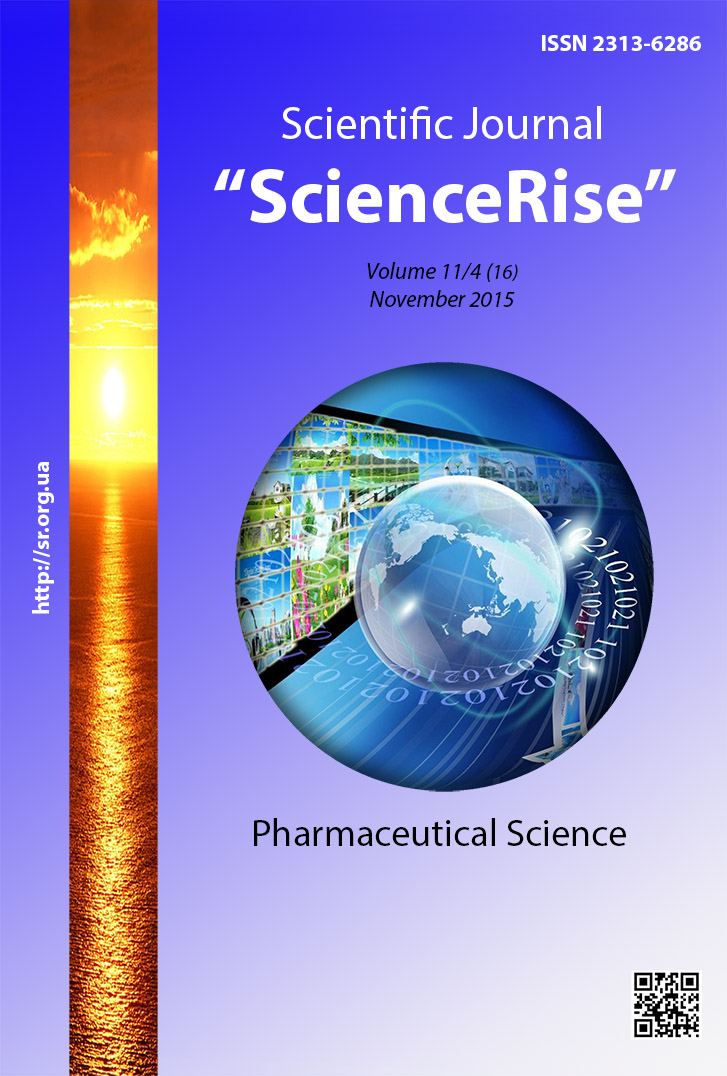Фитохимическое изучение фенольных соединений багульника болотного (Lédum palústre L.)
DOI:
https://doi.org/10.15587/2313-8416.2015.54483Ключевые слова:
багульник болотный, сесквитерпеновые спирты, кумарины, флавоноиды, агликоны, катехины, оксикоричные кислотыАннотация
Цели. Данная работа посвящена фитохимическому изучению биологически активных веществ багульника болотного (Lédum palústre L.), а также исследованию возможности комплексного использования этого сырья для создания на его основе новых растительных препаратов.
Методы. Объектом изучения служила трава багульника болотного. Разделение выделенных веществ осуществляли с помощью адсорбционной и распределительной хроматографии на различных сорбентах. Структуру выделенных соединений устанавливали с помощью физико-химических методов: данных бумажной (БХ) и тонкослойной (ТСХ) хроматографии, УФ-, ИК- и ЯМР-спектроскопии в сравнении с исходными флавоноидами, их продуктами превращения с достоверными образцами. Для определения агликонового состава флавоноидов использовали кислотный гидролиз. Содержание суммы флавоноидов определяли методом дифференциальной спекторофотометрии в видимой области при длине волны 412 нм по реакции с алюминия хлоридом в пересчете на гиперозид-стандарт (ГП "Украинский научный фармакопейный центр качества лекарственных средств", г. Харьков).
Результаты. В результате проведенных исследований обнаружено более 40 компонентов фенольной природы, из которых идентифицировано 31 соединение. Из них больше всего представлены флавоноиды, относящиеся к флавонолам (11 соединений), катехинам (5). Гидроксикоричные кислоты представлены кофейной, феруловой, хлорогеновой кислотами. Кроме того, обнаружены фенологликозид арбутин, кумарины – кумарин, умбеллиферон, скополетин, эскулетин и эскулин. Дубильные вещества представлены метилгаллатом, пирогаллолом.
Выводы. Вещества флавоноловой природы – 5-метил-кемпферол, авикулярин, полистахозид, кверцитрин, кумарины – эскулетин, эскулин, а также гидроксикоричные кислоты – феруловая, хлорогеновая, неохлорогеновая из багульника болотного нами выделены впервые. Полученные данные обосновывают перспективность комплексного использования багульника болотного для разработки новых эффективных растительных препаратов
Библиографические ссылки
Monografii VOZ o lekarstvennyh rastenijah, shiroko ispol'zuemyh v Novyh nezavisimyh gosudarstvah (NNG) (2010). Vsemirnaja organizacija zdravoohranenija, 165–178. Available at: http://www.who.int/medicines/areas/traditional/monograph_russian.pdf
Action plan for herbal medicines 2010–2011. European Medicines Agency. Available at: http://www.ema.europa.eu/docs/en_GB/document_library/Other/2010/06/WC500093179.pdf
Bannerman, R. H. (1982). Traditional medicine in modern health care. World Health Forum, 3, 8–13.
Rates, S. M. (2001). Plants as source of drugs. Toxicon, 39 (5), 603–613. doi: 10.1016/s0041-0101(00)00154-9
Garnyk, T. P., Tumanov, V. A., Pokanevych, V. V. (2012). Fitoterapija: suchasni tendencii' do vykorystannja v likars'kij praktyci ta perspektyvy podal'shogo rozvytku. Fitoterapija, 1, 4–11.
Harmaja, H. (1990). New names and nomenclatural combinations in Rhododendron (Ericaceae). Ann. Bot. Fenn, 27, 203–204. Available at: http://www.ars-grin.gov/cgi-bin/npgs/html/taxon.pl?410675
Grodzins'kyj, A. M.; Grodzins'kiy, A. M. (Ed.) (1990). Líkars'ki roslýny: Encyklopedýchnyj. Kyiv: Golov. red. URE, 544.
Minarchenko, V. M. (1997). Stan ta vykorystannja resursiv dykoroslyh likars'kyh roslyn Ukrai'ny. Ohor. navkol. pryrod, sered, v Ukrai'ni 1994–1995. Kyiv: Vyd-vo Rajevs'kogo, 30–32.
Chopik, V. I., Krasnova, A. N. (1983). Dikorastushhie poleznye rastenija Ukrainy. Kyiv: Nauk. dumka, 18–19.
Serbin, A. G., Sira, L. M., Slobodjanjuk, T. O.; Sira, L. M. (Ed.) (2015). Farmacevtychna botanika. Vinnyca: NOVA KNYGA, 420.
Maksjutina, N. P., Komissarenko, N. F., Prokopenko, A. P. et. al; Maksjutina, N. P. (Ed.) (1985). Rastitel'nye lekarstvennye sredstva. Kyiv: Zdorov'ja, 280.
Kompendium 2015. Lekarstvennye preparaty. – Available at: http://compendium.com.ua/atc/R05#R05C_A22**
Belousova, N. I., Han, V. A., Tkachev, A. V. (1999). Himicheskij sostav jefirnogo masla bagul'nikov. Himija rastitel'nogo syr'ja, 3, 5–38.
Upyr, T. V., Komisarenko, A. M., Koshovyj, O. M. (2014). Terpenoi'dnyj sklad efirnoi'olii' travy Ledum palustre. Farmhimija ta farmakognozija, 23 (4), 408–412.
Levashova, O. L., Gaponenko, V. P. (2015). Poisk i sozdanie anal'getikov prirodnogo proishozhdenija. Svіt medicini ta bіologіi, 2 (50), 144–146. Available at: http://repo.knmu.edu.ua/bitstream/123456789/9565/1/%D0%B0%D0%BD%D0%B0%D0%BB%D1%8C%D0%B3%D0%B5%D1%82%D0%B8%D0%BA%D0%B8%20%D0%BF%D1%80%D0%B8%D1%80%D0%BE%D0%B4%D0%BD%D0%BE%D0%B3%D0%BE%20%D0%BF%D1%80%D0%BE%D0%B8%D1%81%D1%85.pdf
Petruhina, A. A. (2003). Flavonoidy kak aktivnoe nachalo lekarstvennyh rastenij. Kosmetika i medicina, 3, 40–49.
Mirsalihova, N. M., Pakudina, Z. P. (1977). Flavonoidy – ingibitory Na+, K+ – ATF-azy. Himija prirodnyh soedinenij, 1, 44–45.
Dranik, L. I. (1968). O fenol'nyh soedinenijah nekotoryh rastenij semejstva slozhnocvetnyh. Artishok (Cynarascolymus L.). Fenol'nye soedinenija i ih biologicheskie funkcii. Moscow, 53–60.
Georgievskij, V. P., Komisarenko, N. F., Dmitruk, S. E. (1990). Biologicheski aktivnye veshhestva lekarstvennyh rastenij. Novosibirsk: Nauka, Sibirskoe otdelenie, 336.
Zapromjotov, M. N. (1964). Biohimija katehinov. Moscow, 294.
Cancer. Factsheet № 297. World Health Organization (WHO). Available at: http://www.who.int/mediacentre/factsheets/fs297/en/
Загрузки
Опубликован
Выпуск
Раздел
Лицензия
Copyright (c) 2015 Валентина Петровна Гапоненко, Ольга Леонидовна Левашова

Это произведение доступно по лицензии Creative Commons «Attribution» («Атрибуция») 4.0 Всемирная.
Наше издание использует положения об авторских правах Creative Commons CC BY для журналов открытого доступа.
Авторы, которые публикуются в этом журнале, соглашаются со следующими условиями:
1. Авторы оставляют за собой право на авторство своей работы и передают журналу право первой публикации этой работы на условиях лицензии Creative Commons CC BY, которая позволяет другим лицам свободно распространять опубликованную работу с обязательной ссылкой на авторов оригинальной работы и первую публикацию работы в этом журнале.
2. Авторы имеют право заключать самостоятельные дополнительные соглашения, которые касаются неэксклюзивного распространения работы в том виде, в котором она была опубликована этим журналом (например, размещать работу в электронном хранилище учреждения или публиковать в составе монографии), при условии сохранения ссылки на первую публикацию работы в этом журнале .

